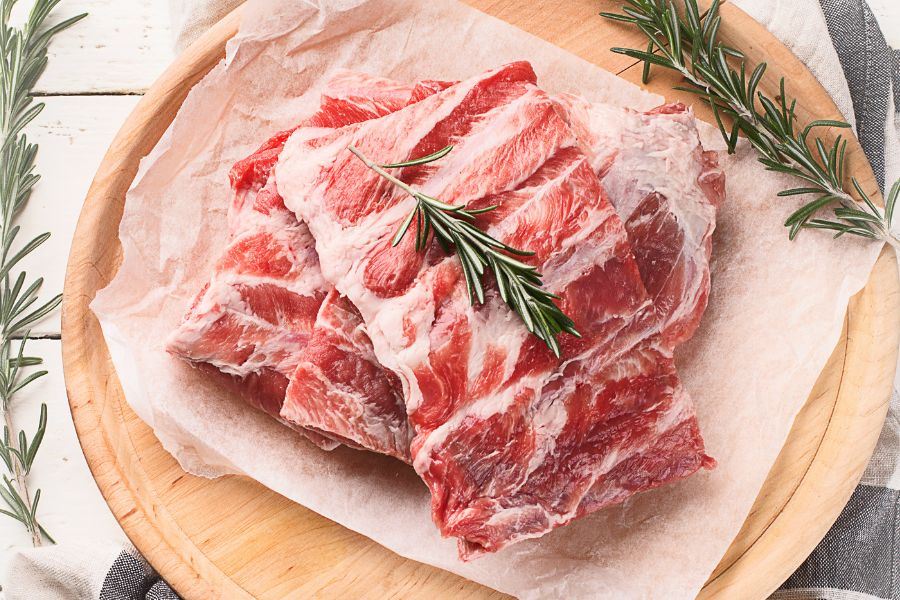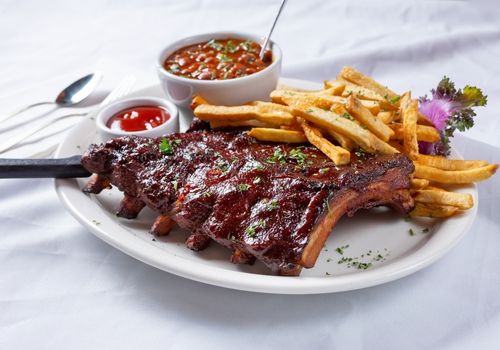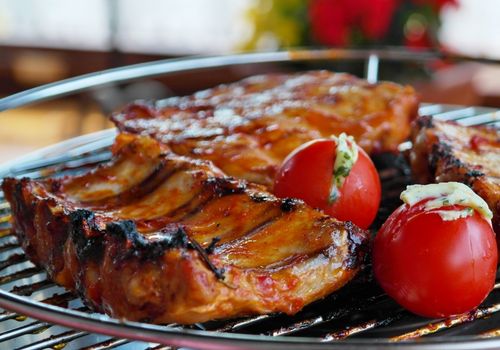You’re probably most familiar with spare ribs. I feel the spare rib is the overall best of the two if we have to start a spare ribs vs baby back ribs comparison. Yes, baby back ribs are more tender and leaner, but they’re quite expensive.
The deliciously grilled spare rib meat almost always melts in your mouth. It is meatier and has more bones and fat marbling. Spare ribs are tasty cuts and they’re more flavorsome than baby back racks.
I learned how to make these racks in cooking school. So whenever I had to grill pork for my barbecue recipes, they’re always high up on my list. So, permit me to show you the peculiarities and differences between the spare ribs and baby back ribs.

First, here’s a side-by-side baby back ribs vs spare ribs comparison so you can see the differences for yourself:
| Baby Back Ribs | Spare Ribs |
Origin | found in the upper rib between spine and abdomen | lower rib piece on the belly of the pig (approx. ¾ of the complete rib cage) |
Alternative names | loin ribs, cutlet ribs, little ladder | belly ribs, peeling ribs |
Appearance | shorter than spare ribs, more curved, with less meat | long, slightly curved, with a high proportion of meat between the ribs |
Taste | More beefy flavor | Flavorful with lingering aftertaste |
Meat texture | tender and lean | coarser and more marbled compared to baby back ribs |
Preparation | cook slowly at low temperatures (Low & Slow) | cook slowly at low temperatures (Low & Slow) |
Strictly speaking, the baby back ribs lie above the spare ribs. They are shorter, more curved, and are closer together. This means there is less meat between the baby back ribs than the spare ribs. However,the meat is more tender in structure but has lower fat content than spare rib cuts because the fat percentage increases towards the belly.
The baby back ribs and spare ribs may be from the animal’s ribs, but the differences are clear. A baby back rack is more tender and leaner than spare ribs. This is because they are nearer to the loin meat at the back. In some cases, they can have about half an inch of loin meat attached. They tend to have a higher price tag.
I have to say spare ribs tend to have more flavor. They are more fleshy, bony, and fatty. This cut is the complete package!
I’ll always take it over the baby backs. The only reason why you might want to go for the baby back ribs is if you’re watching your fat consumption. In any case, you should always stay away from pork with large fat deposits.
For the same pounds of these cuts, the spare ribs have more calories. A rack is enough for a hungry adult.
For those who are very diet-conscious, below is the nutritional information for spare ribs and baby back ribs for every 2 ounces of cut:
Pork Spare Rib | Pork Baby Back Ribs | |
Calories | 225 | 164.4 |
Total Fat | 17.2 grams | 11.3 grams |
Saturated fat | 6.3 grams | 4 grams |
Cholesterol | 68.6 mg | 51 mg |
Protein | 16.5 grams | 13 grams |
If you separate the baby back ribs from the remaining ribs, you get the classic spare ribs. They range from the end of the baby back ribs to the gristle part of the pork belly. The spare ribs, in turn, can be separated into the famous St. Louis cut and rib tips.
This subdivision is very simple: for the St. Louis style ribs, the tips of the ribs and the cartilage part of the pork belly are removed. This gives fans a cleanly separated rib cage section with particularly high meat content.
No, don’t mix it up. The pork loin back ribs and baby back ribs are all the same. Pork loin back ribs, pork back ribs, baby back ribs, and loin rib cuts, these are all the different names that are used for the same type of cut.

Baby back ribs are cuts of meat close to the backbones but beneath the loin muscle. Looking at the pig’s dorsal skeleton, the ribs begin at the spine and encircle the chest to the abdomen. Roughly the first third of the ribs on the spine goes by many names. These can be loin ribs, baby back ribs, or just baby back.
Because the bones of the spine are a little closer together, there’s a little less meat between the heavily curved ribs and less fat. This upper part of the ribs is called baby back ribs in the US because the smallest rib pieces are created with this cut.
The baby back is the uppermost part of the pork ribs in the transition to the back (loin meat). Although the baby back ribs are not the classic spare ribs, they are often sold under this name in the trade.
Ribs are a classic for low-and-slow, i.e. slow cooking at low temperatures on the grill or in the smoker.
Regarding preparation, baby back ribs do not differ significantly from spare ribs – with one small difference: they have a finer meat structure, so the preparation time is a little shorter.
In addition, due to the low-fat content, they can overcook quickly and you’ll have dried-out edges. That’s why I always recommend the 2-2-1 grilling method, rather than the common 3-2-1 approach.
My tip:Just keep an eye on the core temperature of baby back ribs. Don’t cook past medium doneness, which is 145 degrees Fahrenheit internal temperature max.
Incidentally, baby backs are also ideal for preparation in your Dutch oven. When braised in a little liquid (stock or BBQ sauce), they become wonderfully delicious. The advantage here: They stay juicy.
The term spare ribs, strictly speaking, only means the ribs come close to the pork belly, above the sternum, which is the pig’s breast bone. A spare ribs cut is taken at the ends of the baby back ribs.
The bottom two-thirds of the ribs, from the loin rib to the belly area, are called spare ribs. The bone is less curved here and there is more meat between the ribs.
The intramuscular fat content increases towards the belly and thus also the flavor intensity and the juiciness of the meat. That’s why spare ribs are the classic pork rib cuts for the grill.
In the US, they are an absolute BBQ classic and they are also one of the most popular grill specialties. Although they take a lot of time to prepare, the result is always worth it.
The classic cut for the spare ribs is the lower ¾ of the pork ribs. Compared to the baby backs above, the pork ribs here are longer, less curved, and are farther apart.
The proportion of meat between the rib bones is correspondingly higher. So, that means what you have here are small bones.
The two cuts also differ in the meat structure and the fat percentage increases towards the abdomen.

The St. Louis cut is a special cut of spare ribs that – how could it be otherwise – comes from the US, the homeland of BBQ.
For St. Louis cut, the cartilage part of the pork belly and the chewy cartilage are removed. This gives BBQ fans a cleanly separated rib section with particularly high meat content.
The St. Louis spare ribs are particularly used for the popular Johnny Triggs ribs recipe.
Compared to baby back ribs, the meat of St. Louis cut is slightly longer-fibred and therefore a little more al dente.
At the same time, the intramuscular fat content increases towards the belly and ensures a higher flavor intensity and juiciness.
The St. Louis cut is also popular in restaurants and used for competitions. Incidentally, the severed tips are the rib tips mentioned above.
In terms of taste, these are in no way inferior to the other cuts. Especially in the barbecue scene, the breast tips are a popular alternative to St. Louis ribs or baby backs.
Here, so-called rip tips are cut off so that only the rib bones with the meat in between remain.
Low and slow – that’s the key to the perfect spare ribs! Slow cooking at low temperatures on the grill or in the smoker makes the meat wonderfully tender.
The classic approach here is the so-called 3-2-1 method. This means that the spare ribs are first indirectly grilled or smoked for 3 hours, then steamed for 2 hours, and glazed for another 1 hour.
To keep it real, the baby backs are the “little brother” of spare ribs. They may be smaller, but they are almost as tasty as spare ribs when prepared the right way. Baby back ribs are leaner, tender, and less fatty.
On the other hand, the meat of the spare ribs is somewhat coarser and has more marbling. The higher fat content keeps the meat wonderfully juicy when grilled or smoked.